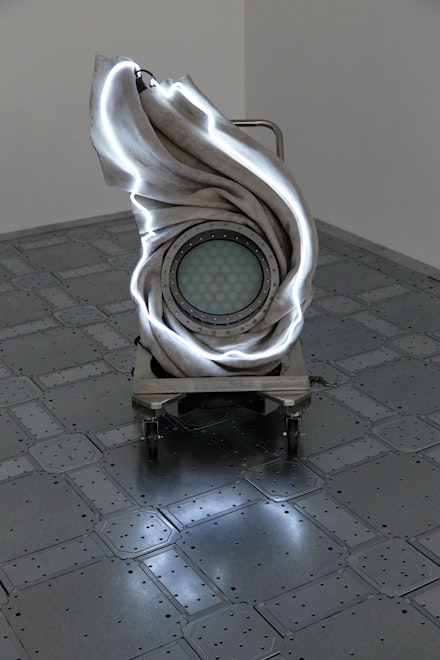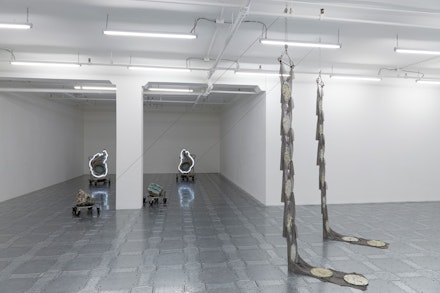ArtSeen
Elaine Cameron-Weir: strings that show the wind
Cameron-Weir does not shy away from showing us the entrails of things, plumbing the places and systems we rarely think about.

New York City
JTTstrings that show the wind
September 8 – October 27, 2019
That the elements of Elaine Cameron-Weir’s works are at once ruggedly utilitarian and impossibly arcane is one of her brilliant conceits. For instance, what exactly is “concrete cloth”? The colorless sheet that twists and clings in sweeping folds like sensual wet-drapery on a classical statue in her sculpture it thought you were someone else it thought you were me bounded by strings in the distorted phases of a topological superfluid a mysterious density half-speed vortices and long walls (2019) is just what it sounds like: a flexible fabric impregnated with concrete, used to line ditches or prevent erosion on slopes. In this work and its counterpart—the pieces in Cameron-Weir’s first solo exhibition at JTT Gallery in New York, strings that show the wind, consist of three not-quite symmetrical pairs—the material plays a similar protective role, acting as a swaddling cloth for the circular glass object that sits snugly in its center: a telescope lens crafted by the artist’s father. Contoured by neon tubing and displayed on stainless steel trolleys rather than pedestals, the concrete whirlpools resemble oyster half-shells brandishing translucent pearls. On the floor of each rolling cart rests a hemispherical candelabrum dispersed with replenishable liquid candles. In the steely, bluish twilight of the surrounding installation, their lambent flicker is incongruously warm and beckoning.
Titled after the verses of a poem written by Cameron-Weir, which are unveiled one by one in a press release authored by artist Jo-ey Tang, the six works presented here are marked by material oppositions that reveal themselves gradually. At first, the scene at JTT conjures a perfectly futuristic vision, a sterile world of slick chrome and white walls, its frosty remoteness made cooler by the steel module flooring system typically found in data centers that has been installed in the gallery. Slowly, contradicting configurations become apparent. Cameron-Weir’s structures are complex amalgams of seemingly incompatible sensibilities, improbable composites of religious paraphernalia and clinical gizmos that find common ground between faith and diagnostics; coldness and affection. As with her most memorable gestures, such as her juxtaposition of a small military-style shelter and a hollow sphere inspired by the “globes of death” used in motorcycle stunt riding for the Storm King Art Center’s Outlooks commission in 2018, Cameron-Weir proves herself a master of physical tensions, balancing polar expectations in a thrillingly precarious, yet sturdy, equilibrium.

Another sculptural couple consists of strips of chainmail, as native to medieval armor as to contemporary knife-proof gear in butcher shops, connected to form two long, vertical sashes suspended from the ceiling. They dangle from hangers fashioned of meat hooks and metal rods taken from laboratory equipment (the latter somewhat of a wellspring for the artist), attached to a pulley system counterweighted by polished fluorite blocks placed—once again—on wheeled trolleys. Affixed to each square of chainmail is a pewter cast made from different centrifugal molds, the kind used to crank out cheap bijoux and baubles, though it’s hard to recognize them as such without the aid of the press release or a well-informed gallery assistant. The indistinct geometric reliefs on the coin-like discs recall the bolt pattern on car wheels or bizarre replacement parts of an unconventional food processor, but an unlikely elegance tends to belie the heavy-duty backstory of Cameron-Weir’s sculptures. The layered bands of maille fall in a vulnerable cascade, lovingly caressing the provisional floor like the train on a wedding gown.
Mounted on adjacent walls at the far end of the gallery are two triptychs whose components borrow bits and pieces from the first four artworks: we all go to work by proxy but it dreams of wires and it was setting the sun it thought it had lost everything but then it found you instead and woke up laughing (2019); and the witnesses turned away he signed the moon out of bed and fact folded back yielding a crumpled up smile a discarded face finally familiar it was setting the sun it was waiting for you (2019). Their tripartite frames are constructed of stainless steel laboratory rods, presumably of the same ilk as the bottom bar of the hanging mechanism in the suspended sculptures. The two outer wings are stretched with rawhide panels adorned with a tentacular chandelier arm and a limp military whip antenna. In the middle section hangs a shorter series of the previously seen chainmail-and-pewter cast motif, and behind each rawhide panel two distinct sources of light emit a diffuse glow, a wormlike section of neon tubing on one side and a solitary liquid candle on the other. Evocative of winged altarpieces, they summon a parallel rush of fear and possibility, echoing the cryptically hopeful coda of the poem from which they draw their titles.
Cameron-Weir does not shy away from showing us the entrails of things, plumbing the places and systems we rarely think about. I picture her patiently haunting industrial junkyards, abandoned factories, and obscure eBay pages, digging up discontinued military apparel, medical apparatuses, rods, clamps, nails, tubes, bulbs, instruments of fetishism and tools of surveillance for her sculptures of imposing beauty. In strings that show the wind, she has introduced another element: silence. The modular tiles that make up the gallery floor are quietly austere, and the distance between each set of works is significant, as is the artist’s decision to create pieces that mirror each other. The result is an aesthetic chamber where forms, textures, and concepts reverberate. What does this exhibition sound like? Another line from Cameron-Weir’s poem might hold a clue: “An echo sliding downtown the mercurial reflective pool of a familiar voice.”

